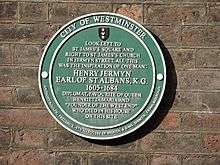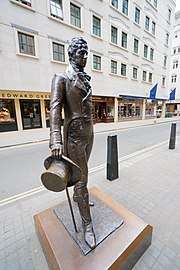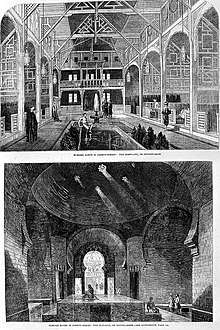Jermyn Street
Jermyn Street is a one-way street in the St James's area of the City of Westminster in London, England. It is to the south of, parallel, and adjacent to Piccadilly road. Jermyn Street is known as a street for gentlemen's-clothing retailers.
.jpg) Jermyn Street decorated for Queen Elizabeth II's Diamond Jubilee in 2012 | |
| Namesake | Henry Jermyn, 1st Earl of St Albans |
|---|---|
| Length | 0.3 mi (0.5 km) |
| Location | London, United Kingdom |
| Postal code | SW1 |
| Nearest Tube station | |
| East end | Haymarket |
| To | St James's Street |
| Other | |
| Known for | Gentlemen's clothing retailers |
History




The street was created by and named after Henry Jermyn, 1st Earl of St Albans, as part of his development of the St James's area of central London, around the year 1664.[1] It was first recorded as "Jarman Streete" in the 1667 rate books of St Martin's, which listed 56 properties on it. In 1675, there were 108 names listed.[2]
Notable residents
Many tailors owned or still own the houses along the street and often rented out rooms to people. No. 22, Jermyn Street, for instance was once owned by Italian silk merchant Cesare Salvucci and a military tailor who rented rooms out to people such as the banker Theodore Rothschild.
The Duke of Marlborough lived there when he was Colonel Churchill, as did Isaac Newton (at No. 88, from 1696-1700; he then moved next door to No. 87, from 1700 to 1709, during which time he worked as Warden of the Mint), the mid-18th century highwayman and apothecary William Plunkett, the Duchess of Richmond, the Countess of Northumberland and the artist John Keyse Sherwin (in whose rooms in 1782 the actress Sarah Siddons sat for him for her portrait as "Euphrasia).[3]
The Gun Tavern[4] was one of the great resorts for foreigners of revolutionary tastes during the end of the 18th century, whilst Grenier's Hotel was patronised by French refugees. At the Brunswick Hotel, Louis Napoleon took up his residence under the assumed name of Count D'Arenberg on his escape from captivity in the fortress of Ham. Twentieth-century residents included the 1930s 'big band' singer Al Bowlly (killed in his flat on the street by a parachute mine during the Blitz in 1941).[5]
Though he did not live there, a statue of the dandy Beau Brummell stands on Jermyn Street at its junction with Piccadilly Arcade, as embodying its elegant clothing values. Aleister Crowley lived in No. 93 during the Second World War up until 1 April.[6] It was through Crowley that Nancy Cunard resided in a flat in Jermyn Street .[7]
Businesses
Jermyn Street shops traditionally sell shirts and other gentlemen's apparel, such as hats, shoes, shaving brushes, colognes, braces and collar stiffeners. The street is famous for its resident shirtmakers such as Turnbull & Asser, Hawes & Curtis, Thomas Pink, Harvie & Hudson, Charles Tyrwhitt and T. M. Lewin. Gentlemen's outfitters Hackett and DAKS are located on Jermyn Street, as well as shoe- and boot-makers John Lobb and Foster & Son. A number of other related businesses occupy premises on the street, such as the men's luxury goods brand Alfred Dunhill, who opened its shop on the corner of Jermyn Street and Duke Street in 1907; barbers Geo.F. Trumper, and Taylor of Old Bond Street; and cigar shop Davidoff;
The street also contains Britain's oldest cheese shop, Paxton & Whitfield, trading since 1797. Floris, a perfumers in the street, has display cabinets acquired directly from the Great Exhibition in 1851.[8]
Forming part of the St James's Art District, there are a number of art galleries in Jermyn Street, including The Sladmore Gallery. Shops in this district are required to display art as part of their lease.
Among the restaurants in the street are the historic Wiltons, the long established Rowley’s Restaurant, the new Fortnum and Mason restaurant, and Franco’s. Tramp nightclub and the 70-seat Jermyn Street Theatre (the West End's smallest)[9] are also on the street.
Many of the buildings on Jermyn Street are owned by the Crown Estate.
Listed buildings
| Street Number | Grade | Date First Listed | Historic England | |
|---|---|---|---|---|
| 14 & 15 | II | 30 May 1972 | [10] | |
| 25 | II | 30 May 1972 | [11] | |
| 30 Simpsons | II* | 14 Sept 1970 | [12] | |
| 70-72 | II | 14 Jan 1970 | [13] | |
| 88 | II | 4 Oct 1974 | [14] | |
| 89 | II | 4 Oct 1974 | [15] | |
| 90 | II* | 14 Jan 1970 | [16] | |
| 93 | II | 1 Dec 1987 | [17] | |
| 94 | II | 30 Jan 1987 | [18] | |
| 95 | II | 1 Dec 1987 | [19] | |
| 96 | II | 1 Dec 1987 | [20] | |
| 106 | II | 1 Dec 1987 | [21] | |
| 111 & 112 | II | 14 Jan 1970 | [22] | |
| Piccadilly Arcade | II | 30 May 1972 | [23] |
Notes on Listed Buildings
Most of the buildings appear in 'Survey of London' in The Parish of St James Westminster Part 1 South of Piccadilly: Volumes 29 and 30, Vol. 29, (1960) which can be viewed online. [24]
Nikolaus Pevsner writes in "The Buildings of England" of No 97 “ The Mid Victorian shop-front of No 97 is one of the best of its date in the West End” and “No 93 is another good one” (Paxton & Whitfield).[25]
See also
- Savile Row: the London street famous for making bespoke suits
- Fleet Street: the London street famous for its newspapers and media
- Harley Street: the London street famous for its private medical practitioners
- List of eponymous roads in London
References
- Lanier, Pamela (2001). "Elegant Small Hotels: A Connoisseur's Guide". A Lanier guide, Lanier Pub. International. p. 211.
- F. H. W. Sheppard, ed. (1960). "Survey of London: volumes 29 and 30: St James Westminster, Part 1". British History Online. pp. 271–284. Retrieved 13 October 2014.
- "British History Online: Appendix: Some distinguished residents and lodgers in Jermyn Street". www.british-history.ac.uk. Retrieved 26 September 2016.
- Wheatley, Henry Benjamin; Cunningham, Peter (1891). London, past and present; its history, associations, and traditions. London, J. Murray; New York, Scribner & Welford. p. 307. Retrieved 7 September 2016.
- "THE COMING OF THE CROONERS". www.shsu.edu. Retrieved 7 September 2016.
- Grant, Kenneth (1991). Remembering Aleister Crowley by Kenneth Grant. Introduction. London: Skoob. Retrieved 7 September 2016.
- Chisholm, Anne (1979). Nancy Cunard : a biography (1st ed.). New York: Knopf. p. 272. ISBN 978-0394492001.
- "London's West End". Great British Railway Journeys. Series 6. Episode 9. 15 January 2015. BBC. Retrieved 15 January 2015.
- "Which is London's Smallest Theatre?". Londonist. 14 May 2016. Retrieved 26 September 2016.
- Historic England. "14 & 15 Jermyn Street (1274532)". National Heritage List for England. Retrieved 8 September 2016.
- Historic England. "25 Jermyn Street (1275730)". National Heritage List for England. Retrieved 8 September 2016.
- Historic England. "30 Jermyn Street, Simpsons (1226639)". National Heritage List for England. Retrieved 8 September 2016.
- Historic England. "70-72 Jermyn Street (1216767)". National Heritage List for England. Retrieved 8 September 2016.
- Historic England. "88 Jermyn Street (1277360)". National Heritage List for England. Retrieved 8 September 2016.
- Historic England. "89 Jermyn Street (1275733)". National Heritage List for England. Retrieved 8 September 2016.
- Historic England. "90 Jermyn Street (1277361)". National Heritage List for England. Retrieved 8 September 2016.
- Historic England. "93 Jermyn Street (1216774)". National Heritage List for England. Retrieved 8 September 2016.
- Historic England. "94 Jermyn Street (1231889)". National Heritage List for England. Retrieved 8 September 2016.
- Historic England. "95 Jermyn Street (1231891)". National Heritage List for England. Retrieved 8 September 2016.
- Historic England. "96 Jermyn Street (1275740)". National Heritage List for England. Retrieved 8 September 2016.
- Historic England. "106 Jermyn Street (1275741)". National Heritage List for England. Retrieved 8 September 2016.
- Historic England. "111 & 112 Jermyn Street (1216785)". National Heritage List for England. Retrieved 8 September 2016.
- Historic England. "Piccadilly Arcade (1265804)". National Heritage List for England. Retrieved 8 September 2016.
- "Survey of London British History Online". www.british-history.ac.uk. Retrieved 8 September 2016.
- Cherry, Nikolaus Pevsner ; revised by Bridget (1984). London ([3rd ed.] ed.). Harmondsworth: Penguin. pp. 592–3. ISBN 0140710124.
External links
| Wikimedia Commons has media related to Jermyn Street. |